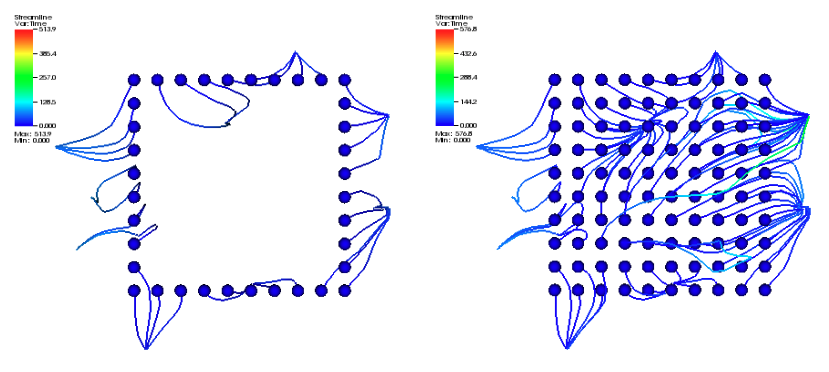4.3.14.1. Integral Curve operator¶
The Integral Curve Operator allows the user to compute an integral curve from a seed point through a vector field without any analysis of its structure.
4.3.14.1.1. Source¶
The set of points that seed the integral curves. In addition to the Source attributes common to all ICS operators, the Integral Curve operator supports the following attributes:
4.3.14.1.1.1. Source type¶
The source type controls how the seeds for the curves are created. There are various options, the names of which are self-descriptive such as creating them along a line or around a sphere. Only those options that require further clarification are described further here.
- Point List
Seed from a list of points. In addition to Add Point, Delete Point, and Delete All Points, the user can Read Text File that is formatted with one point per each line either as “X Y Z” or “X, Y, Z”.
- Selection
Seed with a named selection.
- Field Data
The seed points are defined by another operator and passed to the Integral Curve operator. The name of the array containing the seed points must begin with the string “Seed Points”.
- Up Axis
The “up axis” serves as the “Y” axis embedded in the plane or circle.
4.3.14.1.1.2. Sampling type¶
For samples taken from a geometric object, there is an option to generate uniform or random samples from the specified region. Random samples can be reproduced by supplying a random number seed.
4.3.14.1.1.3. Boundary vs Interior Samples¶
Samples from a geometric object can be taken either from the boundary or the interior. For example, when sampling a plane, the samples can either lie along the edges of the planar region or within the bounded rectangle, as shown below.

4.3.14.1.2. Integration¶
Specify settings for numerical integrators. In addition to the Integration attributes common to all ICS operators, the Integral Curve operator supports the following attributes.
4.3.14.1.2.1. Integration Direction¶
Sets the integration direction through time. The user can choose from a combination of forward, backward, and directionless. Eigen vectors are an example of a directionless vector field. In order to integrate using a directionless field, any orientation discontinuity must be corrected prior to linear interpolation. That is, all vectors must be rotated to match the orientation of the trajectory. The ICS code will do this processing for standard fields (e.g non-higher order elements).
4.3.14.1.2.2. Termination¶
Integral curve termination can be controlled in several different ways. The termination is based on the most conservative criteria, so only one criteria must be met for termination. The options are:
- Maximum number of steps
The maximum number of integration steps that will be allowed.
4.3.14.1.3. Appearance¶
The appearance tab specifies how the integral curve will be rendered. In addition to the Appearance attributes common to all ICS operators, the Integral Curve operator supports the following attributes:
4.3.14.1.3.1. Coloring¶
There are various coloring options, the names of which are self-descriptive such as coloring the curves with a solid color or according to a seed. Only those options that require further clarification are described further here.
- Average Distance from seed
Each curve is colored according to the average distance of all the points in the curve from the seed.
- Variable
Each curve’s color varies by the value of a scalar variable.
4.3.14.1.3.2. Cleanup¶
Allows the user to remove points along the integral curve according to difference schemes. Options are self-descriptive, with additional information provided here as needed.
- Delete points before
Delete all points that come before a critical point defined by a velocity threshold. This cleaning will reveal when an integral curve may stop advecting because of some other reason than the critical point (i.e. the advection continues temporally but not spatially), so this cleaning will remove all duplicate points leaving the last temporal value. If the last point’s temporal value is different than the value as dictated by the elapsed time or max steps, then the advection may have reached a critical point but terminated because of some other reason.
- Delete points after
Delete all points that come after a critical point defined by a velocity threshold. This cleaning will reveal when an integral curve reaches a critical point (i.e. the advection continues temporally but not spatially, so this cleaning will remove all duplicate points leaving the first temporal value).
Warning
Cleanup will always be called if the user displays integral curves using tubes or ribbon regardless of the settings here because they cannot contain duplicate points.
4.3.14.1.3.3. Crop the integral Curve (for animations)¶
Integral curves can be cropped so that they appear to grow over time. This option is useful for creating animations. Users can crop the curves based on several criteria and within a desired time range.
4.3.14.1.4. Advanced¶
In addition to the Advanced attributes common to all ICS operators, the Integral Curve operator supports the following attributes:
4.3.14.1.4.1. Warnings¶
- Issue warning if the advection limit is not reached
If the maximum time or distance is not reached, issue a warning.
- Issue warning if the spatial boundary is reached
If the integral curve reaches the spatial domain boundary, issue a warning.